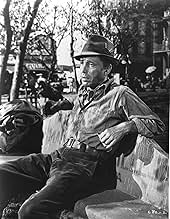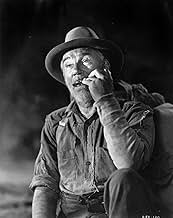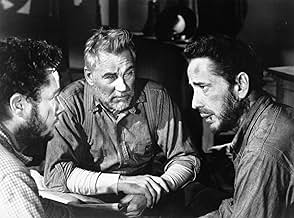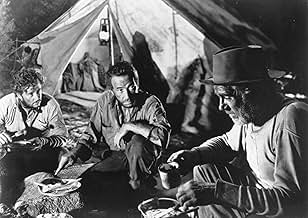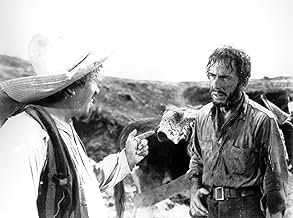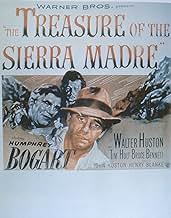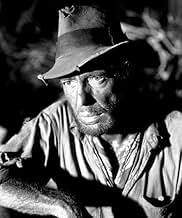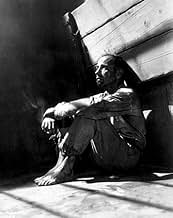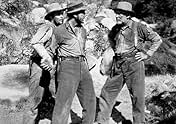Fred Dobbs und Bob Curtin, zwei Amerikaner auf der Suche nach Arbeit in Mexiko, überzeugen einen alten Goldsucher davon, ihnen bei der Goldsuche in den Bergen der Sierra Madre zu helfen.Fred Dobbs und Bob Curtin, zwei Amerikaner auf der Suche nach Arbeit in Mexiko, überzeugen einen alten Goldsucher davon, ihnen bei der Goldsuche in den Bergen der Sierra Madre zu helfen.Fred Dobbs und Bob Curtin, zwei Amerikaner auf der Suche nach Arbeit in Mexiko, überzeugen einen alten Goldsucher davon, ihnen bei der Goldsuche in den Bergen der Sierra Madre zu helfen.
- 3 Oscars gewonnen
- 18 Gewinne & 5 Nominierungen insgesamt
Barton MacLane
- Pat McCormick
- (as Barton Mac Lane)
Arturo Soto Rangel
- Presidente
- (as A. Soto Rangel)
Manuel Dondé
- El Jefe
- (as Manuel Donde)
José Torvay
- Pablo
- (as Jose Torvay)
Robert Blake
- Mexican Boy Selling Lottery Tickets
- (Nicht genannt)
Guillermo Calles
- Mexican Storeowner
- (Nicht genannt)
Roberto Cañedo
- Mexican Lieutenant
- (Nicht genannt)
Spencer Chan
- Proprietor
- (Nicht genannt)
Jacqueline Dalya
- Flashy Girl
- (Nicht genannt)
Ralph Dunn
- Flophouse Bum
- (Nicht genannt)
Ernesto Escoto
- Mexican Bandit
- (Nicht genannt)
Zusammenfassung
Reviewers say 'The Treasure of the Sierra Madre' is a critically acclaimed classic, lauded for its profound examination of greed, betrayal, and human nature. John Huston's direction and screenplay, alongside exceptional performances by Humphrey Bogart, Walter Huston, and Tim Holt, are often celebrated. The film's authentic atmosphere, intricate character studies, and moral complexities deeply resonate. Although some critique its pacing and subplots, most regard it as a timeless masterpiece noted for its psychological depth and thematic richness.
Empfohlene Bewertungen
Two penniless Americans (Humphrey Bogart and Tim Holt) during the 1920s in Mexico join with an old-timer (Walter Huston, the director's father) to prospect for gold. The old-timer accurately predicts trouble, but is willing to go anyway. The film is fictional, but presents a very realistic scenario: By the 1920s the violence of the Mexican Revolution had largely subsided, although scattered gangs of bandits continued to terrorize the countryside. The newly established post-revolution government relied on the effective, but ruthless, Federal Police, commonly known as the Federales, to patrol remote areas and dispose of the bandits. Foreigners, like the three American prospectors, were at very real risk of being killed by the bandits if their paths crossed. The bandits, likewise, were given little more than a "last cigarette" by the army units after capture, even having to dig their own graves first.
The film shows the Americans doing just about anything for money: drilling oil, digging for gold, begging and more. And once gold comes into the picture, the men who once claimed they were not greedy see things differently. Bogart actually goes mad, after he gets greedy and paranoid... during which he encounters a gila monster! The most memorable scene of this film involves the bandits, who don't need any "stinking badges". While the line is much more quotable in "Blazing Saddles", we couldn't have "Blazing Saddles" (or "UHF") without this film... just about everyone, even those who never saw or heard of "Sierra Madre", knows the badges line.
Humphrey Bogart's best film is probably "Casablanca", but this one features him in a nice, rough exterior. Yes, sometimes leading men have beards and are covered in dirt. Pretty boys do not stay pretty boys after digging in the hills, or at least that wouldn't be realistic. This film does a fine job trying to "keep it real", so we have to commend Huston not only on his directing, but his wonderful location scouting.
The film shows the Americans doing just about anything for money: drilling oil, digging for gold, begging and more. And once gold comes into the picture, the men who once claimed they were not greedy see things differently. Bogart actually goes mad, after he gets greedy and paranoid... during which he encounters a gila monster! The most memorable scene of this film involves the bandits, who don't need any "stinking badges". While the line is much more quotable in "Blazing Saddles", we couldn't have "Blazing Saddles" (or "UHF") without this film... just about everyone, even those who never saw or heard of "Sierra Madre", knows the badges line.
Humphrey Bogart's best film is probably "Casablanca", but this one features him in a nice, rough exterior. Yes, sometimes leading men have beards and are covered in dirt. Pretty boys do not stay pretty boys after digging in the hills, or at least that wouldn't be realistic. This film does a fine job trying to "keep it real", so we have to commend Huston not only on his directing, but his wonderful location scouting.
Some movies have certain scenes in them that hold the viewers interest more than others. However every single scene in this film holds the viewers interest. There is never a dull or lagging moment. Three down and outers who at one time in their lives were maybe up and comers strike out in search of a fortune or at least enough to live better than they have been.
While Humphrey Bogart gives a superb performance it is Walter Huston who turns in the greatest performance as the old prospector Howard. The scene in the Indian village where he helps to restore a comatose child is one of the most touching in all of film history and is done virtually without any dialog. Mexican character actor Alfonso Bedoya of course steals all the scenes he appears in and delivers his classic "Stinking Badges" line. (what person would dress up as a Bandito for a costume party and not want to look exactly like Bedoya's Gold Hat character?) This film probably should have been a little higher on AFI's top 100. A must see!
While Humphrey Bogart gives a superb performance it is Walter Huston who turns in the greatest performance as the old prospector Howard. The scene in the Indian village where he helps to restore a comatose child is one of the most touching in all of film history and is done virtually without any dialog. Mexican character actor Alfonso Bedoya of course steals all the scenes he appears in and delivers his classic "Stinking Badges" line. (what person would dress up as a Bandito for a costume party and not want to look exactly like Bedoya's Gold Hat character?) This film probably should have been a little higher on AFI's top 100. A must see!
Tampico sets the scene for the start of speculation, Fred C. Dobbs is out of cash and his luck is in cessation, but an encounter in flophouse, and big dreams emerge and arouse, as a plan is born with Howard, and a fellow who's called Curtin. Into hills laden with gold, our companions then embark, finding seams that come alive with golden riches to impart, building up substantial fortune, thinking soon they will be tycoons, but there's one who's trust is waning and has sores that start to smart. The journey back becomes a challenge to them all, as one by one the group is scattered, battered, stalled, will their work be well rewarded, will endeavours all be thwarted, either way, you will be engaged, and quite possibly enthralled.
Bogarts best performance.
Bogarts best performance.
In the 1920's, labor was hard to find. If you happened to be a laborer, work was almost non existent. Indeed, if you were unemployed and in Mexico, your chances were dismal. Yet, these were the times, which attracted many South of the border. The place was barren, yet many a fortune could spring up directly before you, . . .if you were luckily enough to see it. That is the story behind this incredible film. The legend of El Dorado was only one of the many myths which lured the adventurous to Mexico, another was "The Treasure of the Sierra Madre." The gold of the Mother of Mountains was passed from father to son for generations. Thus when the film adaption was made, it was sure to be sculpted by men of vision. One such man is legendary John Huston who directed this film. Three common men are lured by the promise of discovering a lost treasure. The first is Fred C. Dobbs (Humphrey Bogart) a nice enough guy who wants only to be fair, but is hungry to 'strike it rich.' The second is Howard, (Walter Huston) as honest as you expect him to be and a man of considerable experience. The last is Bob Curtin (Tim Holt) who if given a chance, will use it. The trio make a PAC to share and share alike all the treasure they find. However, only Howard is aware of what the possession of Gold can do to a man. To find the treasure, they need the mountain, some hard work, a little luck. To bring it home, will require something only one of them possesses. The film is a Classic and is due to the combined talents of all the stars and the director. If you look closely, you'll see Robert Blake (Barreta) and John Huston in brief roles. ****
Magnificent rendition of B. Traven's story of ambition and human nature at its worst and dealing with an unlikely trio of ambitious prospectors . As Fred Dobbs (Humphrey Bogart) and Bob Curtin (Tim Holt) , two Americans searching for work in Mexico, convince an old prospector (Walter Huston) to help them mine for gold in the Sierra Madre Mountains . Through a lot of troubles they eventually succeed in finding gold, but greedy outlaws (Alfonso Bedoya) , and most especially craziness lead to disaster . As they sold their souls for the treasure of the Sierra Madre .
It's an intelligent semi-western that scrutinizes the greed and paranoia that afflicts a misfit group , including their enormous difficulties and breathtaking taking on between protagonists and the Mexican enemies that stalk to them . The film blends thrills , emotion , intrigue , high body-count and it's fast moving and exciting ; being filmed in Mexico, though Warners' studio head Jack L. Warner had the unit return to Hollywood when the budget started to exceed $3 million . Thought-provoking screenplay by the same Huston , concerning about greed and ambition that threaten to turn their success into disaster . Director John Huston had read the book by B. Traven in 1936 and had always thought the material would make a great movie . Based on a 19th-century ballad by a German poet , Traven's book reminded Huston of his own adventures in the Mexican cavalry . When Huston became a director at Warner Bros. , the smashing success of his initial effort, The Maltese Falcon (1941), gave him the clout to ask to write and direct the project, for which Warner Bros had previously secured the movie rights . Although by many to be director John Huston's finest film , this is a tale of fear , greed and murder , as three partners fall out over the gold they have clawed out of the inhospitable and bandit-ridden deserts and mountains . It also has probably the most brutal gold bar fight ever put on film along with "The Ruthless Four" . Overrated by some reviewers , but very interesting and attractive to watch . It above all things mostly also remains a real characters movie, in which the three main roles are the essentials . Their dynamic together is also great and is what mostly keeps this movie going . They are three totally different characters, which is the foremost reason why they work out so great together on film . Bogart is superbly believable and gives a nice portrait of an increasingly unhinged prospector , Walter Huston is very good as a cunning veteran and Tim Holt is also pretty well . John Huston has a cameo as an American tourist , this scene was directed by Humphrey Bogart, who took malicious pleasure on his director by making him perform the scene over and over again. And the little boy who sells Bogart the portion of the winning lottery ticket is Robert Blake . The bum seated near Walter Huston in the first scene in the Oso Negro flophouse is Jack Holt, father of Tim Holt . Walter Huston, father of director John Huston, won the Academy Award for best supporting actor , John won for best direction . This was the first father/son win .
The musician Max Steiner composes a vibrant soundtrack and well conducted ; including a catching leitmotif and considered to be one of the best . Atmospheric scenario with barren outdoors , dirty landscapes under sunny exteriors and a glimmer sun and fine sets with striking cinematography by Ted McCord , this was one of the first American films to be made almost entirely on location outside the USA . Also shown in computer-colored version . The picture was shot on location in Tampico, Mexico ; just as John Huston was starting to shoot scenes in, the production was shut down inexplicably by the local government ; it turns out that a local newspaper printed a false story that accused the filmmakers of making a production that was unflattering to Mexico . Fortunately, two of Huston's associates, Diego Rivera and Miguel Covarrubias, went to bat for the director with the President of Mexico , then the libelous accusations were dropped . The motion picture was stunningly realized by John Huston and the film took 5-1/2 months to shoot and was 29 days over schedule ; Robert Rossen submitted at least nine drafts of rewrites on the screenplay when John Huston was away during the war . Rating : Above average . Well worth watching , essential and indispensable seeing . In 2007: The American Film Institute ranked this as the #38 Greatest Movie of All Time.
It's an intelligent semi-western that scrutinizes the greed and paranoia that afflicts a misfit group , including their enormous difficulties and breathtaking taking on between protagonists and the Mexican enemies that stalk to them . The film blends thrills , emotion , intrigue , high body-count and it's fast moving and exciting ; being filmed in Mexico, though Warners' studio head Jack L. Warner had the unit return to Hollywood when the budget started to exceed $3 million . Thought-provoking screenplay by the same Huston , concerning about greed and ambition that threaten to turn their success into disaster . Director John Huston had read the book by B. Traven in 1936 and had always thought the material would make a great movie . Based on a 19th-century ballad by a German poet , Traven's book reminded Huston of his own adventures in the Mexican cavalry . When Huston became a director at Warner Bros. , the smashing success of his initial effort, The Maltese Falcon (1941), gave him the clout to ask to write and direct the project, for which Warner Bros had previously secured the movie rights . Although by many to be director John Huston's finest film , this is a tale of fear , greed and murder , as three partners fall out over the gold they have clawed out of the inhospitable and bandit-ridden deserts and mountains . It also has probably the most brutal gold bar fight ever put on film along with "The Ruthless Four" . Overrated by some reviewers , but very interesting and attractive to watch . It above all things mostly also remains a real characters movie, in which the three main roles are the essentials . Their dynamic together is also great and is what mostly keeps this movie going . They are three totally different characters, which is the foremost reason why they work out so great together on film . Bogart is superbly believable and gives a nice portrait of an increasingly unhinged prospector , Walter Huston is very good as a cunning veteran and Tim Holt is also pretty well . John Huston has a cameo as an American tourist , this scene was directed by Humphrey Bogart, who took malicious pleasure on his director by making him perform the scene over and over again. And the little boy who sells Bogart the portion of the winning lottery ticket is Robert Blake . The bum seated near Walter Huston in the first scene in the Oso Negro flophouse is Jack Holt, father of Tim Holt . Walter Huston, father of director John Huston, won the Academy Award for best supporting actor , John won for best direction . This was the first father/son win .
The musician Max Steiner composes a vibrant soundtrack and well conducted ; including a catching leitmotif and considered to be one of the best . Atmospheric scenario with barren outdoors , dirty landscapes under sunny exteriors and a glimmer sun and fine sets with striking cinematography by Ted McCord , this was one of the first American films to be made almost entirely on location outside the USA . Also shown in computer-colored version . The picture was shot on location in Tampico, Mexico ; just as John Huston was starting to shoot scenes in, the production was shut down inexplicably by the local government ; it turns out that a local newspaper printed a false story that accused the filmmakers of making a production that was unflattering to Mexico . Fortunately, two of Huston's associates, Diego Rivera and Miguel Covarrubias, went to bat for the director with the President of Mexico , then the libelous accusations were dropped . The motion picture was stunningly realized by John Huston and the film took 5-1/2 months to shoot and was 29 days over schedule ; Robert Rossen submitted at least nine drafts of rewrites on the screenplay when John Huston was away during the war . Rating : Above average . Well worth watching , essential and indispensable seeing . In 2007: The American Film Institute ranked this as the #38 Greatest Movie of All Time.
Wusstest du schon
- WissenswertesJohn Huston stated that working with his father on this picture and his dad's subsequent Oscar win were among the favorite moments of his life.
- PatzerAlthough set in the 1920s, many of the cars on the streets of Tampico are of 1930s and 1940s vintage; likewise, women, when prominently seen, are groomed and dressed strictly in the style of the 1940s.
- VerbindungenFeatured in The Screen Writer (1950)
- SoundtracksBelieve Me If All Those Endearing Young Charms
(1808) (uncredited)
Music traditional
Played on harmonica by Walter Huston
Top-Auswahl
Melde dich zum Bewerten an und greife auf die Watchlist für personalisierte Empfehlungen zu.
Details
- Erscheinungsdatum
- Herkunftsland
- Sprachen
- Auch bekannt als
- El tesoro de la Sierra Madre
- Drehorte
- Kernville, Kalifornien, USA(Kelly's Rainbow Mine)
- Produktionsfirma
- Weitere beteiligte Unternehmen bei IMDbPro anzeigen
Box Office
- Budget
- 3.000.000 $ (geschätzt)
- Bruttoertrag in den USA und Kanada
- 5.014.000 $
- Eröffnungswochenende in den USA und in Kanada
- 144.074 $
- 14. Jan. 2018
- Weltweiter Bruttoertrag
- 5.014.000 $
- Laufzeit2 Stunden 6 Minuten
- Farbe
- Seitenverhältnis
- 1.37 : 1
Zu dieser Seite beitragen
Bearbeitung vorschlagen oder fehlenden Inhalt hinzufügen

Oberste Lücke
What was the official certification given to Der Schatz der Sierra Madre (1948) in Japan?
Antwort

